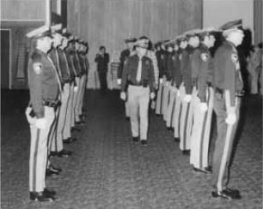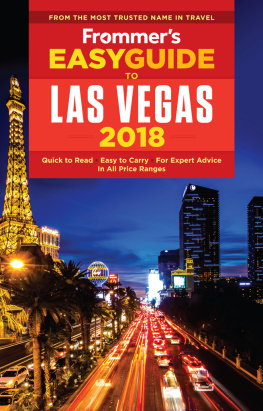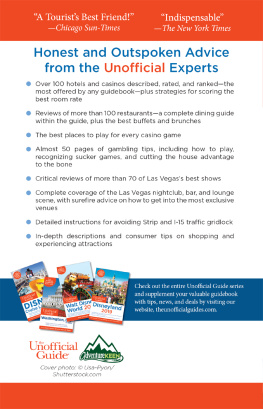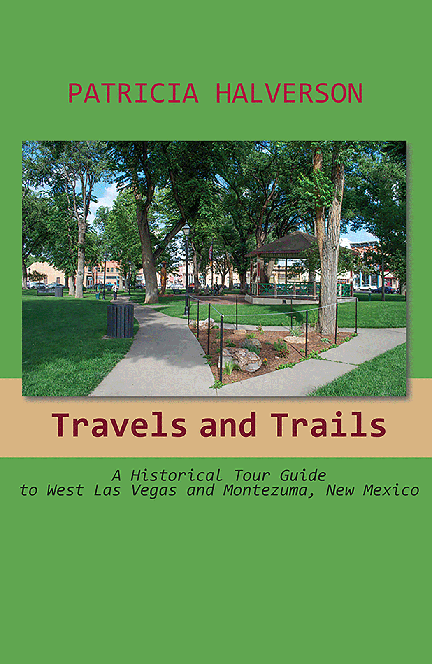Travels and Trails
A Historical Tour Guide
to West Las Vegas and Montezuma, New Mexico
Patricia Halverson
Dedication
I dedicate this book to my dear husband who walked with me during the whole journey from the opening of Travels N Trails Historical Tour Company, to stepping out to begin writing this book. He encouraged me, read and reread pages, held my hand and more. It is a reality due to his help and partnership.
Acknowledgments
For me it takes family and friends to write a book. I wish to thank my editor at Sunstone Press for accepting my manuscript and patiently working with me through the process, my mentor, Michael Olsen who read my old Travel N Trail notes and gave encouragement, to our daughter, Leasa Martinez who was always at the ready to help with computer issues and proofread so many segments of the book, granddaughter, Hailey Botto who willingly contributed a drawing of a historical building and so many friends who lifted my spirits by basically saying, go girl, go.
Introduction: Early Days
In the 15th century two separate papal bulls or pronouncements declared that Christians had the right to displace, and destroy indigenous, non-Christian people and claim their land. In various places across the world this has been upheld by courts of law into the 21st century. But in the 16th century, particularly in Europe it spurred the exploration race.
In the 1530s Cabeza de Baca, and Esteban , a Moorish slave, were part of an expedition exploring Florida. This expedition then headed west and was shipwrecked near Galveston, Texas. Four survived and were captured by Native Americans. When they escaped, they continued their search for a Spanish outpost. Esteban, especially, may have been enthralled by a Portuguese legend from 1150 AD when Moors captured Merida, Spain. According to the legend seven bishops and their congregations were amongst the Christians fleeing the city. The bishops and their flocks boarded seven ships and sailed to perhaps a beautiful island and established wealthy communities. The seed was planted and many were off to find these wealthy Cities of Gold.
Cabeza de Baca and Esteban finally reached the Spanish settlement near El Paso, Texas, but Francisco Vasquez de Coronado was chosen to lead the next expedition. Coronado was a handsome nobleman, a good leader, respected, and could finance the trip! Spain was on a trifold goal in its explorations, to gain lands for the crown, to gain converts for the cross, and to find gold. A Franciscan monk, Fray Marcos, accompanied the group and lure of the legend tainted all of them! By some Coronados 1540 expedition is considered officially as the first Spanish exploration of New Mexico.
To protect the land from others claiming it, Spain and later Mexico needed their own people living on the land especially in the outer areas to act as a buffer zone for the more established communities. To encourage settlement of the newly acquired land, both the Spanish and later the Mexican governments granted large parcels of land to individuals or groups.
The family name Cabeza de Baca (C de Baca) which means head of cow, was one of the early Spanish names in New Mexico. In 1212 the name was given to a Spanish boy who guided the Spanish Army through a pass which he had marked by the skull of a cow. The Cabeza de Baca family came to New Mexico perhaps as early as 1692 to 1696, but not later than 1803. Pea Blanco, New Mexico may have been their first location.
In 1815, the Luis Maria Cabeza de Baca family pulled up grass, threw stones into the four points of the compass and said together three times, long live the king. Thus, they claimed the land at Ojo del Espiritu Santo which is not far from Albuquerque. Navajos made life hard at Ojo, so they resettled at San Miguel del Bado on the Pecos River, the principal town in the province north of Santa Fe. Luis Maria heard about the Gallinas River and on February 20, 1820 applied for a land grant. Despite controversy, Don Luis received the land grant. Officially the grant was known as Las Vegas Grandes or the Great Meadows. This land was really under the jurisdiction of San Miguel del Bado, southwest of Las Vegas, but C de Baca went through Durango, Mexico, for permission.
On May 29, 1821 the land grant was finalized. The Cde Bacas built their ranch buildings near the Gallinas River and the village of Las Vegas began. The family was not aware of the vastness of his land grant, almost 500,000 acres. In 1826 the Rancho de Don Luis Cde Baca was the first house built on the present site of the city of Las Vegas. In 1854, Don Louis passed on but ten of his children were listed in the U.S. Court of Private Land Claims. In 1860, the U. S. recognized Don Luis and family to be the first settlers of Las Vegas. But other settlers to Las Vegas refused that and set 1835 as the founding of Las Vegas.
In 1833 a new group of about 29 people led by Don Juan Dios Maese applied directly to Santa Fe, New Mexico for a land grand. Due to changes in government in both Mexico and Spain they were given the very same land grant. It took the Cabeza de Bacas two years to unite and begin to fight for their land, but it was too late. The new land grant was call Nuestra Seora de los Dolores de Las Vegas and included some land owned in common.
In January of 1855 the United States had issued a notice to all land owners in New Mexico Territory to validate titles and claims at the land office. The Surveyor General, William Pelham was to sort through all these papers and certify ownership. He felt that both the Cabeza de Bacas and the Maese group of 29 people had legal right to claim the land. From 1887 to 1902 the U.S. courts worked on settling these complicated intricacies of the land grant. In 1902 a board was appointed to administer the Las Vegas land grant.
The United States Congress offered a compromise to the complicated problem by asking the C de Baca heirs to forgo their claim to the Las Vegas grant and accept a like amount of land elsewhere. There were five different locations: Baca #1, six miles west of Los Alamos, Baca #2 about ten miles north of Tucumcari, Baca #3 three to six miles north of Nogales, Arizona, Baca #4 in Saguache County in the San Luis Valley in Colorado, and Baca #5 about thirty miles north of Prescott, Arizona. The Cabeza de Baca family granted several of these different plots of land to their lawyer for help in obtaining the entire replacement of their land.
The United States came on the New Mexico scene in 1846 and again the ownership of the land grant was questioned. Finally, Congress decided that the title should be to the Town of Las Vegas because some of this land was held in common by the group. Those who had small tracts awarded to them by the mayor ( alcalde ) of the town of Las Vegas, had the right to keep those lands, but the debate continued as to who owned the large portion.
It went to court and in 1887 Judge Elisha V. Long decided that the lands belonged to the confirmed owner of the grant, the Town of Las Vegas. Later in 1889 this was again decided by the court. The Secretary of Interior refused to recognize the order immediately, because the officials in that department still maintained that the land held in common had become public domain. It went through the courts again and finally by 1902 the confirmation of the decision of the local district court was made. But things were still complicated because the community on the east side of the river, since 1895 known as the City of East Las Vegas could not qualify as the Town of Las Vegas. But on the west side the community was not incorporated, so they could not qualify as the recipient. So, there was a push to have the west part of the community consolidate under the name of the Town of Las Vegas. There was also push to have the two join and the town in the court order be interpreted as referring to the entire community. The citizens on the west side of the river were suspicious of the aims of those on East side and decided that they would incorporate so that they could receive the grant under the name of the Town of Las Vegas.












